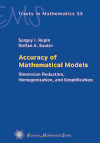- About MAA
- Membership
- MAA Publications
- Periodicals
- Blogs
- MAA Book Series
- MAA Press (an imprint of the AMS)
- MAA Notes
- MAA Reviews
- Mathematical Communication
- Information for Libraries
- Author Resources
- Advertise with MAA
- Meetings
- Competitions
- Programs
- Communities
- MAA Sections
- SIGMAA
- MAA Connect
- Students
- MAA Awards
- Awards Booklets
- Writing Awards
- Teaching Awards
- Service Awards
- Research Awards
- Lecture Awards
- Putnam Competition Individual and Team Winners
- D. E. Shaw Group AMC 8 Awards & Certificates
- Maryam Mirzakhani AMC 10 A Awards & Certificates
- Two Sigma AMC 10 B Awards & Certificates
- Jane Street AMC 12 A Awards & Certificates
- Akamai AMC 12 B Awards & Certificates
- High School Teachers
- News
You are here
Accuracy of Mathematical Models: Dimension Reduction, Homogenization, and Simplification

Buy Now:
Publisher:
EMS
Publication Date:
2020
Number of Pages:
333
Format:
Hardcover
Series:
EMS Tracts in Mathematics
Price:
65.00
ISBN:
978-3-03719-206-1
Category:
Monograph
[Reviewed by , on ]
Bill Satzer
07/11/2022
Unambiguous determination of the accuracy and reliability of mathematical models is a complex problem, very difficult without the kind of complete quantitative verification that is rarely possible. Even when experimental data are compared to the results of a computation based on a mathematical model, differences can arise that are not due to the model itself, but instead to the choice of computational methods, approximations and algorithms.
The questions that arise are very broad. This book explores some of the general issues, but for the most part, the authors actually consider a much narrower class of questions. Although they describe a few examples that compare exact solutions to solutions derived from a model, most of the book looks at comparisons of different mathematical models of the same physical environment, one “complicated” and one “simplified”. The authors also restrict themselves to one class of deterministic mathematical models associated with variational and saddle point problems in mathematical physics. Their goal is to develop a unified approach to the quantitative analysis of accuracy in this set of circumstances.
Early in the book, the authors present an approach that allows the estimation of the distance from approximate computed solutions to exact solutions of elliptic boundary value problems. This involves a good deal of functional analysis to arrive at variational inequalities and error identities.
After this, the core of the book goes on to describe the three techniques identified in the title. Very broadly, dimensional reduction mostly applies to the conversion of a 3D problem to 2D. Homogenization is a method that the authors primarily apply to linear elliptic boundary value problems with complicated boundaries where a troublesome domain is replaced by a simpler one. Simplification is a general notion that the authors use to describe everything else. So, in real-life problems with complicated boundary conditions, geometry, parameters, and data are replaced with a simpler approximate model.
Although the ideas of dimensional reduction, homogenization, and simplification are relevant broadly, the authors don’t provide much guidance beyond the relatively narrow area they examine. This is a text relevant mostly to a narrow group of specialists.
Bill Satzer (bsatzer@gmail.com), now retired from 3M Company, spent most of his career as a mathematician working in industry on a variety of applications. He did his PhD work in dynamical systems and celestial mechanics.
See the publisher's website.
- Log in to post comments




